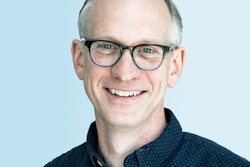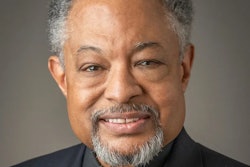They’d Liketo Thank the Academy…
For 10 years, Dr. Regina M. Benjamin volunteered her services at a rural health clinic she founded in southern
Alabama, moonlighting in emergency rooms to support herself and the clinic.
Her efforts went largely unheralded until Pulitzer Prize-winning journalist Rick Bragg featured her in a 1995 New York Times story, “Angel in a White Coat.” The Times feature was followed by articles in other national publications including Time, which placed her on its list of “The Nation’s 50 Leaders Age 40 and Under.” Then came appearances on CBS This Morning, which named her Woman of the Year, and ABC World News Tonight, which dubbed her Person of the Week.
Media attention aside, this rural practitioner, who still heads a clinic in Bayou La Batre, Ala., has one more major credit to her name. In 1997, she received one of the highest honors that can be bestowed upon physicians in the United States: election to the elite Institute of Medicine, or IOM.
Dr. Benjamin clearly is a standout in the medical profession, and uniquely so, because she practices medicine among the poor, the uninsured, the elderly and other patients who are typically under-served. A graduate of Xavier University of Louisiana, the Morehouse School of Medicine and the University of Alabama Birmingham Medical School, she also is associate dean for rural health at the University of South Alabama College of Medicine. With her election to the Institute, she became one of a handful of minorities in the National Academies, an over-arching organization that includes the Institute of Medicine, the Academy of Sciences and the Academy of Engineering, or AOE. The highly respected National Research Council is its operational arm.
More than an honorary society of intellectuals, the National Academies serve as advisers to the federal government on policy issues. The National Academy of Sciences, established by President Lincoln in 1863, was the original academy; the research council, medical Institute and engineering Academy were added over the years.
But if Dr. Benjamin’s election to IOM represents the Research Council’s growing interest in under-represented communities, that’s not yet represented in the number of minorities currently included in the elite organization’s membership.
While hard numbers are unobtainable because Academy officials say they don’t keep such records, “there has been extremely limited progress and improvement for under-represented minorities in the Academies,” says Dr. Richard Tapia, a Latino researcher in the Academy of Engineering.
Perhaps more unsettling is that there don’t appear to be any big movements afoot to change that course. Still, the few minorities who are members of the organization today say the prestige their membership affords them has the potential to greatly expand the reach of Black scholarship.
Representing the Communities
“I had no idea I was being considered,” Benjamin says. “I knew about IOM, and how prestigious it is, but I didn’t think they knew anything about my work.”
Members are not notified of their election until after it has taken place. And Benjamin says she was surprised for other reasons as well. She wasn’t aware that the staid, traditional organization composed mainly of elderly, White males would seek her out. But they did.
Since her induction, she has continued her mission. “I try to be a voice for the patients I see,” she says. “I’ve always thought the patient’s voice should be heard.”
She speaks modestly about her work, but The New York Times article described her activities in glowing terms. “At a time when the nation’s health care industry is becoming dominated by huge insurance companies, for-profit hospital corporations and massive health maintenance organizations, Dr. Benjamin, 38, is a throwback long thought to be extinct: a country doctor with a heart,” the article stated.
As a member of IOM, she contributed to the controversial “cancer burden” report, which concluded that the federally funded National Institutes of Health should devote more resources to determining why some ethnic minorities and under-served communities are more prone to develop cancer than other groups.
Benjamin says that in her continuing representation of these communities on IOM committees, she has “been quite pleased by the emphasis being placed on family and emergency medicine for undeserved populations.”
Tapia’s background in the field of engineering is as stellar as Benjamin’s is in medicine. A professor of engineering at Rice University, Tapia says he has “devoted countless hours to improving diversity in academe in the fields of science, engineering and mathematics.”
In 1990, he was named one of the 20 most influential leaders in minority mathematics education by the National Research Council and was given the Hispanic National Achievement Award for Education from the Society of Professional Hispanic Engineers.
As director of Education and Human Resources at the Center for Research and Parallel Computation, Tapia has organized and directed the “Spend a Summer With a Scientist” program and “Mathematics and Computational Science Awareness” workshops.
Like Benjamin, Tapia has continued to address social issues in the Academy. But unlike Benjamin, who sees progress toward diversity in IOM, Tapia has not been impressed with the numbers of minorities in the Academy of Engineering or the National Academies as a whole.
He does cite “major activity at correcting under-representation of women,” but adds that, “Unlike women, minorities are often not a part of the major network from which members of the academy are sought. A very good minority in an isolated location will clearly fall through the cracks.”
Tapia says he believes greater inclusion of people of color is necessary because of the extremely important role the National Academies play in advising the federal government.
A Colorblind Process
Specific information about the numbers of minorities among the 5,300 members of the National Academies isn’t available.
“It’s very much a colorblind process because they are elected for their scientific accomplishments,” says Susan Turner Lowe, a spokeswoman for the Academies. “We don’t have any information regarding ethnicity of the members.”
There has, however, been a conscientious effort to include more women, Turner Lowe says, adding that during the NAS annual meeting, a workshop was held to address the issue of increasing the number of women among its select membership.
The Academies also have developed a standing committee on women in science and engineering whose sole purpose is to “coordinate, monitor and advocate action to increase the participation of women in science and engineering.”
According to Tapia, the same kinds of efforts should be put forth to boost minority counts.
Another minority member of the Academy of Engineering, Dr. Wesley Harris, professor of aeronautics and astronautics at the Massachusetts Institute of Technology, agrees the Academies should be more diverse. But he also believes his election to AOE was related at least partly to his interest in the advancement of minorities.
Harris cites his research in identifying the multiple sources and significant reduction of helicopter rotor noise as the body of work for which he was selected. But he also says his work on “the successful advancement of minority group members in the engineering profession in academe, government and industry” is an accomplishment that led to his election to AOE.
Since his election, Harris says he has continued to be an advocate for diversity. With a doctorate in aerospace and mechanical sciences from Princeton University, and with more than 100 technical papers published, Harris is an accomplished and prolific scientist.
Yet, he says, “There are many more minority and women engineers who have achieved at a much higher level than I. The Academy should seek out these high-level achievers and invite them to join.”
Like Tapia, Harris — currently on sabbatical at the University of Arizona — isn’t sanguine about the future for minorities in AOE.
“I believe the rate at which women engineers are invited to join the Academy will continue to increase while the rate at which minority engineers are invited to join the Academy will remain constant or decline,” Harris speculates.
Dr. Thomas Rozzell, director of fellowships at National Academy of Sciences, agrees. But he also says AOE is becoming ethnically diverse at a much faster rate than NAS, and that history plays a certain role in the low numbers.
“There are tremendous numbers of minorities over the years who have done things that would have easily landed them in the Academy of Science had they not been minorities,” Rozzell says.
Other Members of Color
Dr. William Julius Wilson, Harvard’s noted professor of social policy, was elected to NAS in 1991. Wilson’s major areas of study are poverty, inner-city school-to-work transition, racial tensions in urban neighborhoods, and the effects of poor neighborhoods on the social outcomes of adolescents. His research also addresses the impact of inequality and poverty concentration on racial and ethnic relations, family structure and joblessness, as well as the role of public policies in both alleviating and exacerbating these problems.
Rozzell says the National Academies have made strides to be more inclusive in other ways. They have initiated a portrait gallery of distinguished African American scientists and engineers, and have extended fellowships to a broad range of women and minorities, most of whom go on to outstanding careers in science, medicine and engineering.
Rozzell notes that Dr. James Gavin, an African American physician at the Howard Hughes Medical Institute, was honored in the portrait gallery and went on to be elected to the IOM. And IOM member Dr. Beatrix Hamburg, former president of the W.T. Grant Foundation, also has been honored in the portrait gallery. Her daughter, Dr. Margaret Hamburg, assistant secretary of health and human services for planning and evaluation for the U.S. Department of Health and Human Services, also is an IOM member.
Other living African Americans in the Institute of Medicine include Dr. A. Eugene Washington, chief of obstetrics at The University of California-San Francisco, and Dr. Helene Gayle, director of the National Center for HIV, sexually transmitted diseases and tuberculosis prevention in the National Centers for Disease Control and Prevention.
In the AOE, in addition to Harris and Tapia, minority members include Dr. Delon Hampton, chairman and CEO of Delon Hampton and Associates in Washington, D.C.; Jesse E. Russell, vice president of Advanced Communications Laboratory in Whippany, N.J.; and Dr. Ronald E. Goldsberry, vice president and general manager of Global Ford Customer Service Operations in Detroit.
The Pioneer Member
Although critics cite the National Academy of Sciences for its apparent lack of minority members, it must be noted that in 1973, African American chemist Percy Lavon Julian was elected to NAS. Julian, who died in 1975 at the age of 76, was noted for having synthesized and identified physostigmine, a drug used to treat glaucoma, to improve memory in Alzheimer’s patients and as an antidote to nerve gas. He also devised a way of filtering the chemicals in soybean oil to allow quantity production of hormones for medical applications.
Julian was born in 1899 in Montgomery, Ala., the grandson of a slave. He earned his undergraduate degree in chemistry from DePauw University, became an instructor at Fisk University and later received a master’s in chemistry from Harvard and in 1931 received his doctorate from the University of Vienna, Austria.
He returned to DePauw and in 1933 conducted the research that led to the synthesis of physostigmine. Julian left DePauw in 1936 to become director of research of the Soya Products Division of the Glidden Company in Chicago.
An entrepreneur as well as a scientist, in 1953 he founded Julian Laboratories and later Julian Associates Inc. He also founded the Julian Research Institute. He acquired more than 115 patents, including one for a fire-extinguishing foam that was used on oil and gasoline fires during World War II.
© Copyright 2005 by DiverseEducation.com





















